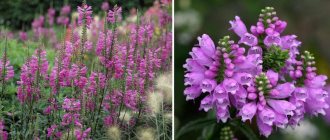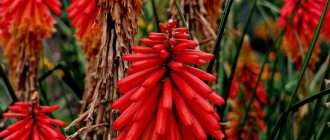Any gardener wants to make his flowerbed amazing and beautiful. To make a flower garden unique, there are a large number of flowers. I consider lavatera to be one of the most worthy of attention. Firstly, this plant blooms for a long time and beautifully, and secondly, it is very unpretentious in care. Lavatera seeds have good germination. Therefore, they can be planted directly into the ground, but in order for the plant to grow faster and bloom faster, to quickly show all its beauty, the seedling method of propagation is more preferable. But first things first.
Lavatera: description
Lavatera flower is popularly called khatma. It belongs to the malvaceae family and is similar in appearance to the hollyhock rose, especially the perennial lavatera. Shrub species, herbaceous crops, and even trees can be found in this genus. The genus is considered relatively small and includes about 25 species.
Rosa lavatera is often found in East Asia; it can be found naturally in Australia and the Mediterranean. The culture is named after the Lavater brothers from Switzerland. They were naturalists, naturalists and doctors. They loved all sorts of unusual plants. And in the 17th century this flower was planted in the garden. But annual and perennial lavatera gained popularity only a few centuries ago. Now this plant can be found in every garden.
Lavatera gardena has been studied by breeders for a long time. And thanks to their work, it was possible to develop many varieties of this extraordinary plant. The height of these plants ranges from 0.5 to 1.5 m. They have a well-developed root system. The stem of the bush is powerful and strong, as are the branches extending from it. The crown is spreading and during the flowering period it is completely strewn with flowers. The leaves of most species are arranged alternately, their blades are lobed and covered with hairs.
The diameter of the largest flowers is 10 cm, the color is the most varied: white, purple, yellow, pink and crimson. Flowers grow from the axils of the bract one or several at a time. Together they form racemose or spike-shaped inflorescences.
The first lavatera flowers can be seen in June, and flowering continues until mid-autumn. That is, this plant will decorate the garden all season. Khatma is ideal for those who have little time, because even without care it will bloom all summer. The plant tolerates periods of drought well, tolerates drafts and strong winds, is very undemanding to the soil, and cut flowers can last in a vase for about a week.
After flowering, the flower forms seed pods, the seeds of which can be sown without fear the following year.
View from above
Both annual and perennial varieties were bred. Tall and dwarf (within 50 cm) annuals live up to 3 months. But the permanent inhabitants of the front garden can reach one and a half meters in height. Such a curly bush of lavatera flowers (here in the photo) captivates with its appearance. Varieties with petals of the following shades are popular:
- white;
- pink;
- yellow;
- purple;
- red.
They differ in the type of inflorescences, which can be single or complex. The first buds appear at the turn of May and June. The plant remains in bloom until October. At the same time, it is impossible to approach the flowerbed. She is surrounded by a swarm of insects that collect nectar/honey. Although Lavatera is a garden rose, it is also used in folk medicine.
Preparations obtained from lavatera roots have anti-inflammatory, expectorant and enveloping effects.
In addition to this healing effect, culture has a beneficial effect on a person’s mental state. In this regard, hutma occupies an important place in landscape design. You can watch and enjoy for hours:
- fast-growing and highly branched bush;
- dark green 3- or 5-lobed leaves with serrated edges;
- funnel-shaped flowers reaching 5-10 cm in diameter.
A photo of lavatera flowers taken in a flowerbed evokes admiration and delight. Such carpet compositions look unsurpassed in the company of other varieties. Observers are especially struck by the contrasting veins on the petals, emerging from the middle and dissipating towards the edge. The unusual color creates the illusion of a corrugated surface. A huge number of side shoots are formed on a powerful bush. They are crowned with luxurious bouquets of garden roses. Towards mid-summer, there are so many buds that they completely cover all the greenery.
The older the perennial lavatera is, the darker its foliage becomes. If it becomes lighter and paler with age, it means that the crop needs to be fertilized with phosphorus- and nitrogen-containing fertilizers.
Lavatera: reproduction
Khatma can be propagated either by seed or vegetatively by dividing the bush. The most commonly used is seed. In regions with a harsh climate, it is recommended to first grow seedlings, and when the threat of frost has passed, lavatera is planted in the ground. In warm regions, plant seeds can be planted directly in open ground.
The vegetative propagation method is most suitable for perennial lavatera. In spring or autumn, divide the mother bush and transplant parts of the plant to the chosen location. Khatma tolerates this procedure well and easily settles into her new place.
Flowering period
Flowers bloom in early June and fall only in mid-September. The flowering period is long, but care is very simple. It is believed that lavatera is an excellent choice for always busy people or for inexperienced gardeners. Flowers can be cut and placed in water; they are very stable and can last in a vase for about 2 weeks. Change the water as needed, trim off dried leaves and buds in a timely manner.
Lavatera: planting seeds in the ground
As mentioned above, in warm regions the plant can be planted directly into the ground. When to plant lavatera seeds ? It is advisable to carry out this procedure in the third ten days of April or early May. Before planting lavaters in open ground, the soil is first dug up and added to 1 sq.m. one bucket of humus or compost, you can add 2 tbsp to organic matter. l. nitrophoska.
After digging the soil and applying fertilizers, the soil is leveled and furrows 1 cm deep are made in the prepared area. The furrows are shed with warm water and dry lavatera seeds are sown in them, preferably the distance between the seeds is 10-15 cm. The furrows are filled with a mixture that should contain 50% from humus and 50% from garden soil. The crops are covered with film.
Usually seedlings sprout within a week. When the plants grow 5 cm in height, the cover is removed, the crops are thinned out, the soil around the seedlings is loosened, as if slightly hilling up the seedlings. If no fertilizers were applied when preparing the soil, then after removing the film, the young plants need to be fed. During this period, complex mineral fertilizer should be applied.
Growing lavatera from seeds
Sowing
In areas with a warm climate, lavatera is sown in open soil in the last days of April, and the first in May. First, prepare the area; for this purpose, 1 bucket of humus or compost and a couple of large spoons of nitrophoska are added to the soil per 1 m2 for digging. After this, the soil should be leveled and furrows about a centimeter deep should be made in it, which should be shed with lukewarm water. You need to sow dry seeds in them, which are covered with a soil mixture consisting of humus and garden soil (1:1). Then the crops must be covered on top with a film, which must be transparent. The first seedlings most often appear after 7 days. After the height of the plants reaches 5 centimeters, the film will need to be removed, the crops will need to be thinned out, and the soil will need to be loosened with a little hilling. If fertilizer was not applied to the soil before sowing the lavatera, then after the shelter is removed, the seedlings must be fed. For this, it is recommended to use complex mineral fertilizer.
Seedling
It is recommended to grow lavatera through seedlings when there is a desire to bring the flowering time closer. If planting seedlings is planned for May, then it is recommended to sow the seeds in the first days of March. For sowing, you should prepare boxes, at the bottom of which you must make a good drainage layer, and they must be filled with purchased soil mixture for seedlings. Afterwards, the substrate is spilled with lukewarm water and dry seeds are planted to a depth of no more than 10 mm. The containers must be covered with film or glass. Do not forget to promptly remove condensation from the shelter and water the crops. After about 15 days you will be able to see the first shoots. They need very good lighting or backlighting, since with a lack of light the plants become excessively elongated and become thin. After the seedlings have grown a little, it will be necessary to remove the cover. Caring for seedlings comes down to systematic watering and regular rotation of the box around its axis, this will help the seedlings develop evenly.
Picking
As a rule, picking wild rose seedlings is not required. After the seedlings grow and become stronger, they can be planted directly into open soil.











